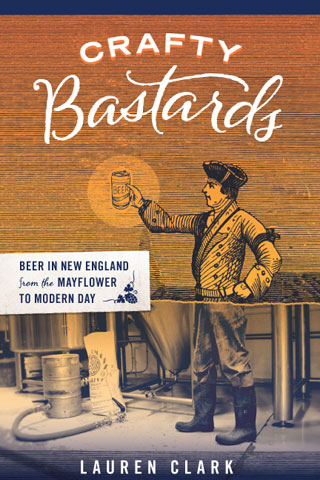September 14th, 2007

Calling all winos — have you been to Bin 26 Enoteca yet? I checked it out for the first time recently and, I have to say, “thumbs up.” This place has been open for, what, a year or something, and it has received tons of good press. Once I wrapped my head around the extensive wines-by-the-glass menu and realized that the prices were fair (especially for Beacon Hill), I leaned back in my cool seatbelt-weave chair and let our doll of a scruffy-haired waiter take over. He was the embodiment of Bin 26’s mission to replace wine appreciation’s tweed blazer with a Ben Sherman track jacket.
Some observations:
The 250 ml portion of “wine by the glass” equals over eight ounces and can easily be split by two people. Prices for 250 ml start at $11. You can also get portions of 100 ml, 500 ml (about two-thirds of a bottle) and 750 ml (a whole bottle).
The bathrooms are decorated with upside-down wine bottles (see photo).
The beef carpaccio with aged parmesan and arugula appetizer ($11) is tasty, and so are the risotto balls stuffed with pecorino cheese ($8).
I got the impression that the staff can both banter with the connoisseur and guide the uninitiated.
The Thunderbird and Night Train listed on the first page of the wine menu: refreshingly irreverent or trying too hard to be hip? You make the call.
An “enoteca” in Italy refers to “a place where one can find simple foods to accompany the wines served there,” according to Bin 26’s website.
Permalink | 1 Comment | Filed under Boston bars, Wine |
September 8th, 2007
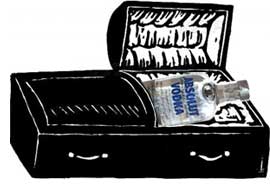 Man, I have really dropped the ball. It has been over a year since I dissed vodka. It’s time, then, for part 3 of drinkboston’s Vodka R.I.P. series. In part 1, I talk about how the ubiquity of this colorless, flavorless spirit has dumbed-down mixology. In part 2, I investigate how this state of affairs came to be. Here, I present evidence that knocks vodka down a few more pegs.
Man, I have really dropped the ball. It has been over a year since I dissed vodka. It’s time, then, for part 3 of drinkboston’s Vodka R.I.P. series. In part 1, I talk about how the ubiquity of this colorless, flavorless spirit has dumbed-down mixology. In part 2, I investigate how this state of affairs came to be. Here, I present evidence that knocks vodka down a few more pegs.
I know, I know. You’re a bartender, and you’re saying, “I have to keep my customers happy! Vodka’s what they want to drink. If I put a bunch of gin and whiskey cocktails on my menu, people will freak. That stuff scares them.”
Here’s something that’ll scare them even more, or at least kill their buzz:
“Achieving the ‘purity’ so essential to the spirit is almost impossible on an artisanal pot still. Making pure ethanol is what industrial stills do best, which is why two of the … major players producing vodka in the U.S. are Archer-Daniels-Midland and Grain Processing Corp. of Muscatine, Iowa. ADM sells its 190-proof beverage alcohol (product code 020001) packaged one of three ways: ‘Bulk Truck, Bulk Rail, Tank.’ Cut it with water … bottle it, and you’re in the vodka business,” writes Eric Felten in the Wall Street Journal (“Make Mine a 020001,” 9/1/07).
Bulk Truck! That’s going to be the name of my new premium vodka. Does it get any more obvious that the path from America’s largest agricultural processor to a $40 bottle of Grey Goose is paved with marketing wiles and consumer gullibility? Bartenders, if a vodka-drinking customer remains unfazed by this fact and says, ‘Who cares? I like the smooth taste of Brand X,’ you might run another Felten tidbit by him:
“I went to a vodka tasting hosted by the head of a prominent luxury liquor house. After being walked through the vodkas on the table with elaborate descriptions of the characteristics of each, I found myself hard-pressed to discern much difference. So I asked the executive to demonstrate the differences by tasting the vodkas blind. He couldn’t even identify his own flagship brand.”
I’m not saying that some gins, rums, tequilas and other big-name “premium” spirits aren’t produced in industrial quantities. But they aren’t as dependent as vodka on high-falutin’ claims of purity and sophistication. They have distinguishable flavors that come from their base ingredient, i.e. sugar cane or agave, or from botanicals like juniper, or from barrel aging. Vodka doesn’t. Claims of purity and sophistication are all it has. And now that the vodka market is so crowded, marketers are trying to set their products apart by, for example, touting earth-friendly distillation methods and packaging (360 Vodka) or organic ingredients (Square One Organic Vodka).
One way that vodka makers have been trying to wring money out of the category for years now is through flavors. You know, vanilla, raspberry, orange (or “oranj” if you’re Stoli — ooh, such stylish spelling!), etc. I recently sat down with a PR woman for the Van Gogh vodka brand at the South End bar 28 Degrees. She gave me samples of several Van Gogh vodkas, including pineapple, acai-blueberry, chocolate and espresso. She wanted to know what I thought of them. I told her that the flavors were authentic enough — the pineapple tasted like pineapple, the espresso tasted like espresso — but that they were not at all interesting for someone like me, who actually enjoys the taste of spirits and seeks out drinks whose ingredients form an actual Cocktail, as opposed to something that merely mimics another food or beverage.
On occasion, people say to me something like, “So I have a pomegranate vodka martini and I enjoy it. So what? No one gets hurt.”
Right, no one gets hurt. Except for the people who are desperately seeking a drink that tastes like a drink and not like a dessert or a cup of coffee or a glass of fruit juice. And with a lot of vodka mixology, you’re lucky if you get even that. The one cocktail that I sampled at 28 Degrees, the Prosciutto and Melon, was not even as mildly pleasant as I thought it would be. I was imagining a drink that tasted like spiked fresh cantaloupe. Instead, the drink tasted strangely metallic. And the kicker was the garnish. The strip of prosciutto that was wrapped around the ball of melon left little beads of animal fat floating atop the puréed cantaloupe-melon vodka mixture. Ick. Is this really the sort of drink people want to pay $12 for?
Permalink | 20 Comments | Filed under Boston bars, Cocktails, Vodka |
August 31st, 2007
Michael Jackson, the British drinks writer known as the Beer Hunter, died yesterday in London. He was 65. If you have visited a beer bar or brewpub and enjoyed the flavorful, varied selection of beverages found therein, you can thank Jackson for that. He basically invented the field of beer writing in the 1970s and ’80s and thereby shepherded and hugely influenced the worldwide beer renaissance that has occurred since then.
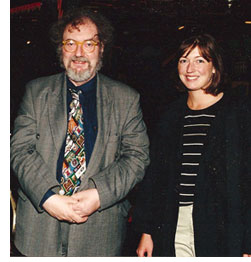 He inspired most if not all of the beer writers working today, including me. I have a few of his books: Great Beers of Belgium, the Bar and Cocktail Companion and an autographed copy of the Beer Companion. He also inspired artisanal brewers in the U.S. who lovingly revived the near-forgotten beer styles these books describe — stuff like porter, bock and IPA. It is in large measure because of him that mass-produced light lagers no longer monopolize the beer market like they did 20, 30 years ago.
He inspired most if not all of the beer writers working today, including me. I have a few of his books: Great Beers of Belgium, the Bar and Cocktail Companion and an autographed copy of the Beer Companion. He also inspired artisanal brewers in the U.S. who lovingly revived the near-forgotten beer styles these books describe — stuff like porter, bock and IPA. It is in large measure because of him that mass-produced light lagers no longer monopolize the beer market like they did 20, 30 years ago.
Jackson succeeded because he wrote well. In his columns, he could be witty and poignant in the same paragraph, and his descriptions of drinks were concise and expressive, not florid. He wrote like he was talking to you, bringing you along on a pub crawl around the world. I met him briefly only a couple of times, including at a 1999 dinner at Redbones BBQ, where the above photo was taken. Philadelphia-based beer writer Lew Bryson knew him fairly well and wrote a heartfelt remembrance of the man, who had fought Parkinson’s disease over the past several years.
In the Beer Companion, Jackson describes what it’s like to drink Kolsch beer in its city of origin, Cologne, Germany. Many of us have had vivid, poetic beer-drinking experiences, but Jackson could actually put those experiences into words:
“In Cologne’s brewpubs during the early evening, small casks are raised from the cellar by dumb-waiter, tapped, and exhausted within minutes. To the visitor, in the jostled space of the standing area (known to the locals as the Schwemme, or ‘swimming bath’), it is an impressive sight. The waiters, whose uniform jackets or shirts are traditionally blue, over leather aprons, carry specially designed circular trays that hold the glasses like cartridges in a revolver.”
Permalink | 1 Comment | Filed under Beer, Books & resources |
August 24th, 2007
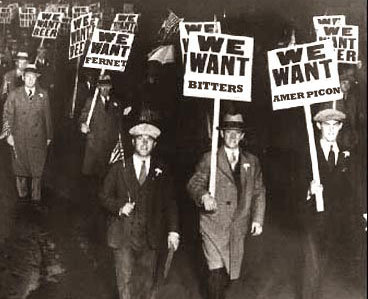
Looking for lost cocktail ingredients? Know where to shop for them? Read on.
OK, enough. It really shouldn’t be that hard to find ingredients for the pre-Prohibition cocktails we’re all crazy about and attempting to mix in our homes when we’re not ordering them in bars. In the past week, people have asked me where they can purchase Peychaud’s bitters, orange bitters, Amer Picon, Fernet Branca — even rye whiskey, for chrissakes! Then there’s the really weird stuff like Swedish punsch and creme de violette. One reader has taken it upon himself to purchase cases of bitters and absinthe online and then sell them (at cost) to fellow cocktail enthusiasts (thanks, Adam!). That is commendable. But, um, shouldn’t someone else be doing that on a larger, more profitable scale? Like, say, a liquor store?
Sure, some liquor stores mentioned here in the past — Blanchard’s, Wine & Cheese Cask, Downtown Wine & Spirits, Martignetti’s, Beacon Hill Wine, Atlas in Medford — carry one or two of these ingredients, but none of them stock a decent, dependable selection. Why not? I’m guessing it’s because not enough people have asked them to. Well, folks, it’s time. Please join me in Operation 1919 — a mission to make lost and rare cocktail ingredients readily available to the home mixologist. We must do the cyberspace equivalent of standing en masse outside Boston’s finer booze purveyors and chanting: “What do we want? Peychaud’s bitters! When do we want it? Now!”
Leave a comment on this post and tell me a) which vintage cocktail ingredients you’re looking for and b) whether you have found such ingredients in the Boston area — or anywhere in New England, for that matter. I will then pass our wish list on to the proprietors of the above and other establishments in hopes that they’re interested in serving a niche market. Ready, set, demonstrate!
Permalink | 53 Comments | Filed under Bitters, Drinking supplies |
August 21st, 2007
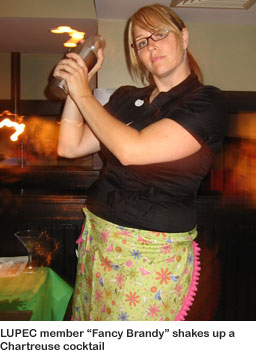
I’m guessing that when the monks of the Order of Chartreuse created their “liqueur of health” in 1737 they never imagined that, three centuries later, mixed-drink enthusiasts in the New World would gather at a Chartreuse cocktail party thrown by a group of debauched dames called Ladies United for the Preservation of Endangered Cocktails.
That’s precisely what went down at Green Street in Cambridge last night. Drinkboston.com joined the Boston chapter of LUPEC to celebrate the herbaceous Chartreuse liqueur and the evocative elixirs that result when you mix it with, oh, gin and cucumbers. We served up two old-school Chartreuse cocktails and two new-school Chartreuse cocktails (see recipes below) while a monkishly robed local bartender and drinks historian bestowed his knowledge and blessings on those gathered.
Misty Kalkofen, Green Street bar manager and president of LUPEC Boston, and her fellow Ladies (who all go by aliases that are names of drinks) created two new cocktails specifically for the event. One of them, the Irma La Douce, was a winner in Salon.com’s recent cocktail contest. It and the other featured cocktails were shaken to perfection by the Ladies and were damn tasty. Proceeds from the event got LUPEC started on its mission to throw co-ed cocktail events that raise funds for local women’s charities. Check the LUPEC blog in the coming weeks for information about an event in October.
The Can Can (created by LUPEC Boston)
5 sour cherries
1 oz yellow Chartreuse
.25 oz fresh grapefruit juice
1 dash Angostura Bitters
sparkling wine
Muddle the sour cherries in a mixing glass. Add the Chartreuse, grapefruit juice, and bitters. Shake with ice and strain into a flute. Top with sparkling wine. This drink’s name is inspired by its peppery kick.
The Irma La Douce (created by LUPEC Boston)
1.5 oz Hendrick’s gin
.5 oz green Chartreuse
.5 oz fresh cucumber puree (peel and blend cucumber, then pass through a sieve)
.5 oz fresh lemon juice
.5 oz grapefruit juice
.25 oz simple syrup
Shake all ingredients with ice and strain into a chilled cocktail glass. Garnish with a slice of cucumber. (Don’t want to make a puree? If you’re making this cocktail for one or just a few guests, you can just muddle a few slices of peeled cucumber in a shaker.) A green French liqueur + a movie in which Shirley MacLaine plays a Parisian prostitute dressed in bright green stockings = a drink called the Irma La Douce.
The Champs-Elysees
1.5 oz brandy
.75 oz yellow Chartreuse
.75 oz fresh lemon juice
1 dash bitters
Shake all ingredients with ice and strain into a chilled cocktail glass. This vintage drink is on the regular cocktail menu at the B-Side Lounge.
The Scoff Law
1 oz rye whiskey
1 oz dry vermouth
.75 oz fresh lemon juice
.75 oz green Chartreuse
2 dashes orange bitters
Shake all ingredients with ice and strain into a chilled cocktail glass. This drink, according to Ted Haigh’s book Vintage Spirits & Forgotten Cocktails, was invented at Harry’s New York Bar in Paris and “hilariously baited Prohibition sensibilities (the term originally referred specifically to a frequenter of speakeasies and general flouter of the National Prohibition Act).” Another version of the Scoff Law calls for real pomegranate grenadine instead of Chartreuse. Both cocktails are terrific.
Permalink | 5 Comments | Filed under Cocktails, Events, Liqueur |

 Man, I have really dropped the ball. It has been over a year since I dissed vodka. It’s time, then, for part 3 of drinkboston’s Vodka R.I.P. series. In
Man, I have really dropped the ball. It has been over a year since I dissed vodka. It’s time, then, for part 3 of drinkboston’s Vodka R.I.P. series. In  He inspired most if not all of the beer writers working today, including me. I have a few of his books: Great Beers of Belgium, the Bar and Cocktail Companion and an autographed copy of the Beer Companion. He also inspired artisanal brewers in the U.S. who lovingly revived the near-forgotten beer styles these books describe — stuff like porter, bock and IPA. It is in large measure because of him that mass-produced light lagers no longer monopolize the beer market like they did 20, 30 years ago.
He inspired most if not all of the beer writers working today, including me. I have a few of his books: Great Beers of Belgium, the Bar and Cocktail Companion and an autographed copy of the Beer Companion. He also inspired artisanal brewers in the U.S. who lovingly revived the near-forgotten beer styles these books describe — stuff like porter, bock and IPA. It is in large measure because of him that mass-produced light lagers no longer monopolize the beer market like they did 20, 30 years ago.

